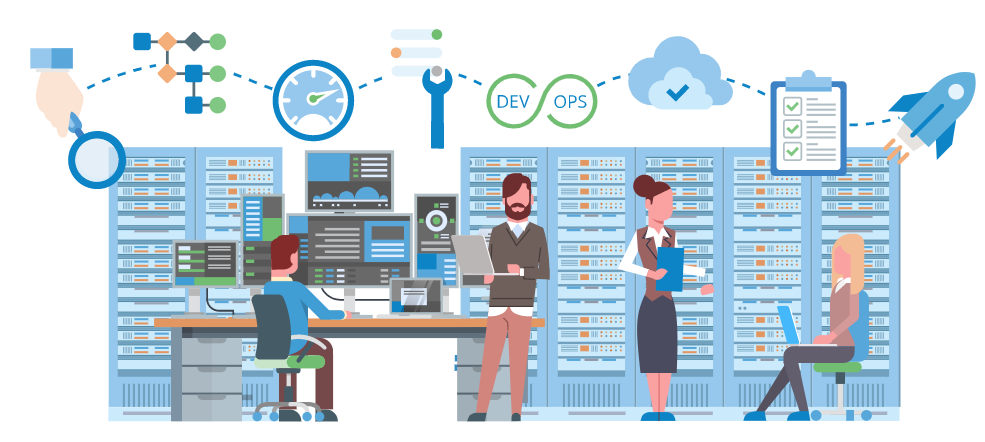A functional IT infrastructure requires a lot of work. Like a marketing or sales department, when one component is out of whack, it can impact the overall IT system. That’s why proper infrastructure management is crucial. Building an IT infrastructure management, whether on your own or with managed IT services, is essential for corporate success.There are several types of managed IT services, so you can choose the niche area that fits your organization’s needs best. But properly managing that infrastructure is the key. The rapidly spreading use of today’s technology poses particular and significant commercial difficulties for businesses and government organizations of all sizes.
Table of Contents
Information technology (IT) infrastructure management is the administration and management of crucial operational aspects to effectively, efficiently, and pro-actively employ technology, information, and data. It should not be confused with the wider duties of IT management. In addition to the hardware that makes up the IT infrastructure, these components also comprise the software, procedures, policies, personnel, training, security, networking, data storage, and mobile and virtual capability. Overall, company operations, objectives, and goals are tightly correlated with IT infrastructure management.
Understanding IT Infrastructure Management

IT infrastructure management aims to control and arrange the processes and activities involved in various technical operations. IT service providers like ITSco ensure the smooth operation of all systems, services, and components. If anything goes wrong, IT infrastructure management helps minimize downtime and sustain productivity. In addition to hardware maintenance, strong data backup and recovery solutions are included.
Benefits of IT Infrastructure Management
Keeping track of your IT infrastructure has many advantages, but here are a few of the most important:
-
Savings
Using real-time asset performance management systems can significantly cut purchasing and usage costs.
-
Preventative Care
Infrastructure management services with intelligent automation enable organizations to plan maintenance and replacement windows rather than reacting to emergencies. Proactive maintenance and replacement reduce unplanned outages and lost productivity.
-
Security
Physical and cyber security are required to keep your IT and data safe. You need both to avoid a data breach, disruption, reputation damage, and expensive penalties.
For physical security, controlled infrastructure facilities will allow only those who are authorized to enter. This means no other data center visitors may physically access your IT. They’ll also have cameras inside and outside the building and a 24/7 crew on site. Colocation is a great choice when it comes to keeping your data safe.
For cyber security, while it’s possible to set up your own cyber security program, it’ll require continual monitoring to keep your firewalls and software up to date. You save your IT team from this burden by entrusting this job to a managed infrastructure provider. They can even handle distributed denial-of-service (DDoS) attacks when volumetric data can flood your IT structure.
-
Efficiencies
Workers can choose more efficient methods of manufacturing with better information. It also enables employees to improve workflow.
How To Enhance IT Infrastructure Management
Changing your infrastructure to make it simpler yet more agile will save you time, effort, and money. By simplifying your equipment and processes, your team will be better able to discover infrastructure weaknesses, such as malfunctioning equipment or suspicious activities.
The following suggestions may help you strengthen your IT infrastructure while streamlining management:
- Use virtualization to boost efficiency by moving the workload to fewer, more powerful servers.
- Prepare for unforeseen infrastructure failures by backing up to the cloud.
- Create a ticketing system to speed up submissions and track user complaints.
- Examine backup reports for suspicious activities.
- Invest in cloud services that enable easy scalability as demand and technology change.
IT Infrastructure And Cloud Services
Cloud service providers have transformed how IT businesses handle critical infrastructure aspects. Previously, for enterprises to digitally transform, they had to own and control their own IT systems.
Cloud computing has made it easier than ever for enterprises to outsource infrastructure management using one of three basic models: Infrastructure as a Service (IaaS), Software as a service (SaaS), and Platform-as-a-Service (PaaS).

- IaaS
IaaS is a new business model that allows the provision of infrastructure programmatically and on-demand. Previously, ordering infrastructure required a purchase order, waiting for delivery and installation in a data center, and then testing your application. Now, through an application programming interface (APIs) or simple click interfaces, developers and organizations may summon any infrastructure they want, whenever they need it.
- SaaS
SaaS allows customers to connect to and use cloud-based software remotely such as email, calendaring, and office tools.
A cloud service provider sells you a complete software solution on a pay-per-use basis. Your users connect to an application via the internet, usually via a web browser.
- PaaS
In the PaaS model, developers rent everything they need to construct an app from a cloud provider, including development tools, infrastructure, and operating systems.
Choosing The Right IT Infrastructure Management Solution For Your Company
Today’s solutions serve different business settings. They stress user-friendliness, immediate insight and views, and proactive monitoring. In addition, these solutions improve industry or business performance.
Before inviting vendors for a demonstration, IT management staff must first identify the capabilities, controls, and monitoring that are necessary and intended to improve operations. With today’s tools, you can manage virtual and physical resources from anywhere and get training, consultancy, and other value-added services from vendors. Thus, it’s critical to pick a solution that meets your specific business needs.
Conclusion on IT Infrastructure Management Services
Modern businesses, regardless of size or industry, rely on IT infrastructure. Companies may automate operations, optimize internal and external pipelines, and set new performance records by integrating technologies.
But without a well-tuned IT infrastructure, you can’t achieve a competitive advantage and may even lose to the competition. To improve your business and its operational aspects, you should consider setting up or updating your IT infrastructure management.

Adhar Dhaval is experienced portfolio, program and project leader with demonstrated leadership in all phases of sales and service delivery of diverse technology solutions. He is a speaker sharing advice and industry perspective on emerging best practices in project leadership, program management, leadership and strategy. He is working for the Chair Leadership Co.
















Thank you for providing a guide on the importance of IT infrastructure management for your business. I love it!
You’ve written it so nicely, and you’ve come up with some great ideas. This is a fantastic post!